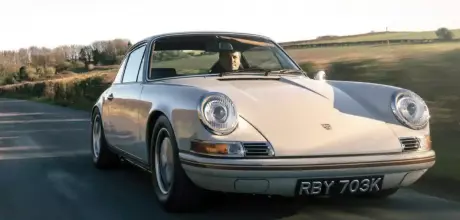Italian-market 244bhp 1972 Porsche 911 T 2.4 by Canford Classics GT
We look forward with the Canford Classics GT, a five-decade-old 911 T reinterpreted for the 2020s…
Words Emma Woodcock
Photography Rich Pearce
GRANDER TOURER
A classic 911 T reinterpreted for the 2020s.
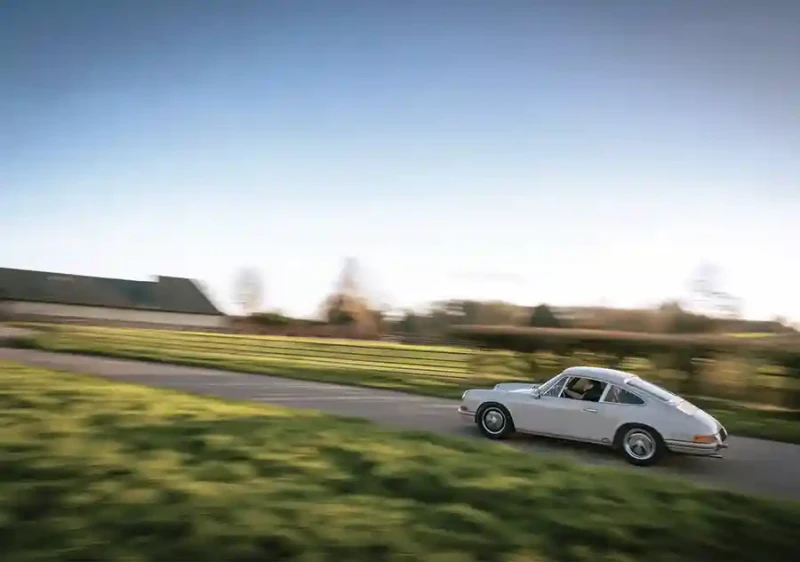
THE CLASSIC 911 SHAPE REMAINS, WITH ONLY THE DOOR SKINS SWAPPED FROM STEEL TO ALUMINIUM
Click the fob. The Canford Classics GT’s alarm system disarms, the doors unlock and the interior bathes in light. Pull the aluminium-skinned door and a puddle lamp twinkles across the ground, illuminating safe passage to tailored wool carpets, a sea of Alcantara and boundless tan leather. Your smartphone starts charging the instant it hits the door pocket. The slats behind the sport seats hold your luggage. LED headlights flood the road. One squeeze of the thick-rimmed, shrunk-down steering wheel confirms it: up-to-the-minute sophistication oozes from every inch of this extraordinary 911, right up until the engine bursts to life with classic air-cooled glamour. Let’s be clear: this is no backdate. The flat-six growling through a bespoke equal-length exhaust system doesn’t hail from a G-series, 964 or 993-generation 911. Canford Classics founder, Alan Drayson, wanted a challenge showcasing the vast in-house capabilities and individuality of his Dorsetbased Porsche restoration company, which meant starting with an Italian-market 1972 Porsche 911 T 2.4 and building toward the future. Enter ‘forward-dating’. “We had to do something different. I wanted to add luxury without losing focus, to equip a 1972 car for modern European touring. Function, purpose and design was paramount,” he explains. “Everything we developed or adjusted would need to serve at least one of these three standards, resulting in a car representing our thoughts and, importantly, our creativity.”
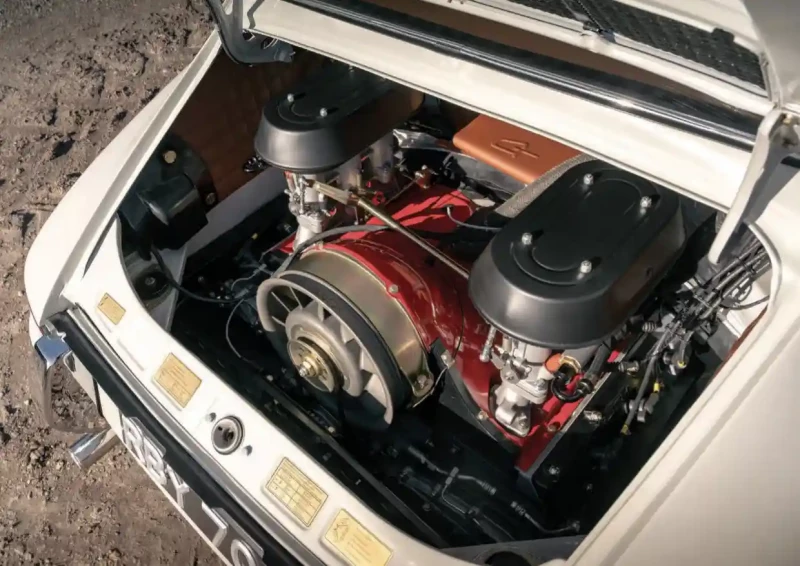
THE BALANCE BETWEEN COMFORT AND CAPABILITY ECHOES THROUGH THE SUSPENSION AND BRAKES
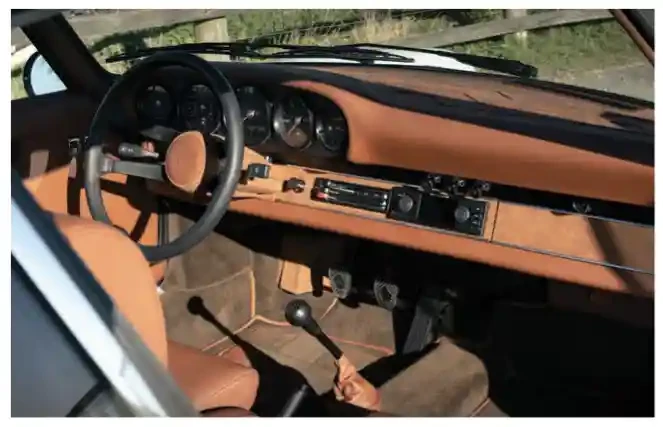
A CARRERA 3.2 EQUIPPED WITH A FOUR-LITRE SCREAMER AND AN SC ENHANCED BY 3.5-LITRE POWER
A small number of mechanical components aside, the task would be undertaken entirely by the Canford Classics team. “I hate relinquishing control,” Alan admits. “Everything matters on a project such as this. Overseeing every stage of the process, all jobs undertaken in-house, means we’re fully invested, from the instant an idea pops into my head to the day our technicians or trimmers incorporate it into the car, adding their own design flare in the process.”
Rear-engined renovation is a way of life at Canford Classics. Operating from a suite of former farm buildings just outside the village of Winterborne Kingston, the seven-strong team dedicates itself to every aspect of air-cooled Porsche restoration. The workshop rings out with engine, transmission and suspension rebuilds. The company even carries out its own crankcase machining, as well as interior trimming. Cross the yard and a dedicated welding room tackles panel adjustment, rust repairs and parts fabrication. A Junair spray booth ensures paintwork boasts a flawless finish.
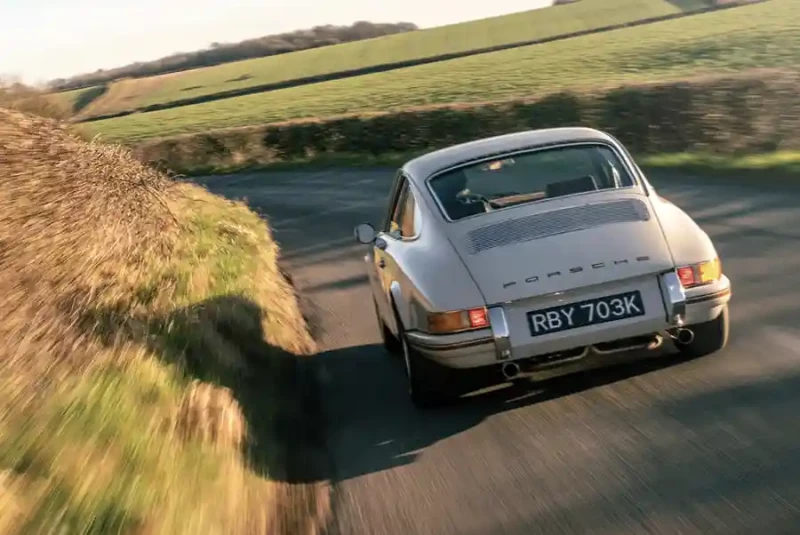
The company relishes a challenge. Alan responds to vanishingly rare components and previously unexplored avenues for air-cooled innovation by rolling up his sleeves and crafting solutions from scratch. Research avenues range from highflow cylinder heads to heated carpets holding an interior at the perfect ambient temperature. Every component, no matter how small, is a valuable part of the bigger picture. Every Canford Classics client benefits from Alan’s obsessive attention to detail, whether their Porsche rolls into the workshop for suspension refurbishment, an engine rebuild or full restoration. Evocation is another talent — previous projects include a screaming Carrera RSR 2.8 resto-modification and a faithful recreation of the Slate Grey 911 S Steve McQueen drives in the opening sequence of his motorsport movie magnum opus, Le Mans. “We work down to the smallest detail. This approach reflects back on us. When a customer wants a factory standard car, we work hard to achieve absolute originality.”
Creation, design, specification, fabrication, build, trim, engine and transmission enhancement, paint, testing and final completion. Alan has nurtured this 911 through every step of its twoyear transformation, always seeking to weave subtlety and usability into the build. “We worked hard to make sure the GT wasn’t too loud, too abrupt, too bright. The car is intended to be an integral part of a driver’s cross-continental journey, meaning travel needs to be enjoyable and easy.” His approach can be observed in the retained Porsche long-range fuel tank, the bespoke brass oil lines — which work with a Carrera 3.2 oil cooler to keep engine temperatures at bay — and the uprated Wosp alternator providing power for (among other features) the heated seats. Nowhere is Alan’s vision clearer than the bespoke interior, though.
“Design and craft run through everything we’ve developed in the cabin,” he explains. “We haven’t created a single part for the sake of it.” He points to the Alcantara dashboard top. The synthetic suedelike material forms of a streak flashing over the dash, doors and horn push to soften the interior, while limiting reflections in the windscreen. Bespoke door cards add further functionality, providing nifty phone-charging storage bins, mounts for the electric windows and concealed umbrellas.
Details matter and they’re everywhere you look.
Remote central locking makes it easier to climb aboard, Porsche Classic Communication Management (PCCM) plans the route and time-delay headlights help you step confidently to your door at journey’s end. Meanwhile, a full-size spare wheel sits snug inside a custom cover in the wool-lined frunk and is accompanied by bespoke bracketry holding a jack, breathalyser and high-visibility vest. All three items are legal requirements when driving in mainland Europe. Head back inside the cabin and even the redesigned dials — note the gold font, 180mph speedometer and absent redline — hide consideration behind their visual flare. The oil and fuel gauges, meanwhile, have been rotated to provide a better view through the restyled rim.
Not that you’ll look past the steering wheel at first glance, of course. Period styling cues crackle from its quad spokes and contrast-trimmed circular horn push, the latter finished to earlier short-wheelbase 911 specification. And yet, Canford Classics has tailored every dimension of this original Porsche four-spoke — the factory 400mm diameter has been cut back to 355mm for more immediate responses, the prongs are dramatically bent to dish the wheel (and to create a relaxed driving position) and the rim is double-wrapped to provide a thick and certain grip. Each change might be small, but the result is an interior transformation.
The theme continues outside. Drink in the Dolphin Grey outline and the bodywork enhancements are everything and nothing, all at once. The classic 911 shape remains, with only the door skins swapped from original steel to lightweight aluminium, yet the LED headlights and bespoke exhaust finishers slung below the rear bumper add subtle menace. Squint closer still and you might spot the LED third brake light hiding in the rear air vent. This is an important safety feature for a classic 911 living in a world of high-rise SUVs.
The 1972-specific body-side oil filler has morphed from its original ellipsis into a perfect circle. And this is to say nothing of the most fundamental (but least visible) exterior alteration. As part of a restoration including new inner and outer sills, front wings and bonnet (all parts sourced directly from Porsche), the body has been imperceptibly hand-flared across its back bumper and rear wheel arches to accommodate seven-inch-wide Fuchs alloys. “We worked hard to keep the car looking long and straight, even with the thicker wheels in place,” Alan tells us.
“So much of this car is bespoke, but I don’t want it to look that way. It has to remain a 1972 911.”
The matchingnumbers machine retains its original flat-six, albeit with substantial redevelopment. Canford Classics rebuilt and flowed the cylinder heads, fitted a range of new internals, all parts were fully balanced and swept capacity was upped to 2.5 litres before the installation of PMO throttle bodies and electronic fuel injection for increased engine control. Hours spent on the company’s recently installed dyno honed the specification. “This equipment is transformative,” Alan grins. “There’s no more tuning on the road, no guessing, no unknowns.” The benefits of new workshop machinery show best in the stainless steel exhaust.
Weeks of iterative design refined the equal-length system to uniquely match the oversized flat-six, bolstering performance and providing an exciting-yet-restrained soundscape. The note is never too loud or too raw, but you always know you’re driving an air-cooled 911. Enjoying an 115bhp increase over standard power and nearing output of 100bhp per litre, the reconstructed boxer peaks at 244bhp.
Rebuilding the original five-speed gearbox matches the driveline to its grand tourer task. “Our concept wasn’t ultimate performance,” Alan stresses. “It was all about offering a fast cruise at low revs.” A reinforced side plate and single bearing retainer add necessary strength to cope with the extra power, while the fitment of a later 911 crown ring and pinion works with lengthened fourth and fifth gears to create high-speed civility. The balance between comfort and capability echoes through the suspension and braking systems, which are enhanced by more recent Porsche parts without losing their classic 911 essence. For example, torsion bar suspension remains, but the bars themselves are upgraded to Carrera 3.2 units, working with early 911 Turbo (930) anti-roll bars to tighten cornering responses. Bilstein sport-specification shock absorbers increase damping control.
“Coilovers would have been going too far,” says Alan. “At that point, you should just buy a 964!” Excess is also banished from the brakes. After trialling 930 discs and six-piston calipers, Canford Classics eschewed overkill and fitted the GT with smaller but better-matched Carrera 3.2 stoppers.
When the Canford Classics GT rolled onto the road in 2019, it represented the state of its builder’s art, but much can change in four years. Always looking for ways to improve, Alan and his team are taking concepts from the Dolphin Grey machine and advancing them for upcoming projects. Where the GT boasts the luxury of heated seats, for example, new bespoke Canford Classics 911s will also benefit from heated steering wheels and thermostatically-controlled carpet warming. Also, by holding the car at ambient temperature during trickle charging, the systems eliminate the annoyance of fogged-up windscreens.
Intricate engineering extends under the rear lid, where the since-sold GT points the way with a data-driven development programme. “The sheer amount of work we carried out on flow and velocity distinguished the GT from our previous projects and continues with our latest cars. Designing our own parts was the next logical step,” Alan reveals. “We now create our own thin-stem valves and use an in-house flow bench to find the best cuts and sizes for each powerplant.” Experience gained in fuel injection and electronic engine management also translates to upcoming Canford Classics projects, with drive-by-wire throttle and ‘autoblip’ gearshift rev-matching planned for the near future.
Thinking big defined the next two 911s to benefit from Alan’s approach to forward-dating: a Carrera 3.2 equipped with a four-litre screamer and an SC enhanced by full chrome delete and 3.5-litre power. “We’re building larger capacity flat-sixes, but focusing far more of our engineering work on the cylinder heads,” Alan reveals. “Since we installed our dyno, we’ve learned as much about what our engines haven’t got as what they have. It’s a new way of thinking, which really interests me. We’re limited by airflow and the flat-six configuration, but we’ve started looking at high-speed secondary fuel injection systems and even manufacturing our own billet cylinder heads.”
Like every other Canford Classics project, the GT wasn’t complete until Alan had honed every component to his satisfaction. “You wouldn’t buy a suit off-the-peg if you wanted it to fit perfectly,” he reasons. “Though they’re fantastic already, air-cooled Porsches can be considered from the same viewpoint. With this in mind, each of our cars is tailored.” Take the pinstriped decals and the matching bonnet badge, all colour-keyed to the interior on the sixth exacting attempt, as evidence of what he’s talking about. “We thought about them, then we designed them. They tip their hat to what we built the car to be. It’s original, but it’s modified.”
Below The Canford Classics GT started life as a 911 T 2.4 supplied in Italy back in 1972.
Above Colour-coding extends to exterior pinstriping, rear Porsche script and a bespoke GT logo along the flanks.
Below Alan’s careful execution has ensured travelling in style is the order of the day.
Above Oversized 2.5-litre flat-six develops a healthy 244bhp, enabling the GT to keep up with modern traffic on Europe’s busy autoroutes.
Above and below The Canford Classics GT’s interior is a work of art, retaining period charm, but including a wide variety of electronic trickery and some of the most comfortable car seats you’ll ever encounter.
Above All the charm of a classic 911, but packed with tech (and a redeveloped flatsix) to make the car better suited to modern-day touring in mainland Europe.


